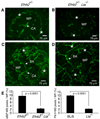The lymphotoxin LTalpha(1)beta(2) controls postnatal and adult spleen marginal sinus vascular structure and function
- PMID: 19303389
- PMCID: PMC2874947
- DOI: 10.1016/j.immuni.2009.01.010
The lymphotoxin LTalpha(1)beta(2) controls postnatal and adult spleen marginal sinus vascular structure and function
Abstract
The lymphotoxin LTalpha(1)beta(2) supports the development and maintenance of several aspects of spleen structure, but its significance for marginal sinus (MS) vascular organization is unclear. We showed here that, in early postnatal lymphotoxin-deficient mice, the developing Flk-1+ white pulp vessels failed to organize or upregulate MAdCAM-1, leading to altered spatial rearrangement of both the white pulp endothelial cells and the smooth muscle actin-expressing cells. In vitro, MAdCAM-1 directed the reorganization of LTbeta receptor+ endothelial cells grown on Matrigel. LTalpha(1)beta(2) also regulated the maintenance of both MAdCAM-1 expression and mature MS structure in adult mice, contributing importantly to normal trafficking of CD11b+ cells in response to bacterial antigens. Together, our studies demonstrate that LTalpha(1)beta(2) and LTbeta receptor signals control proper development and maintenance of the mature MS structure and implicate MAdCAM-1 in the structuring of the MS endothelial cells that is important for the movement of immune cells within the spleen.
Figures






Similar articles
-
Distinct roles of lymphotoxin-beta signaling and the homeodomain transcription factor Nkx2.3 in the ontogeny of endothelial compartments in spleen.Cell Tissue Res. 2007 Jun;328(3):473-86. doi: 10.1007/s00441-007-0378-6. Epub 2007 Feb 21. Cell Tissue Res. 2007. PMID: 17318587
-
Lymphotoxin-β receptor activation by lymphotoxin-α(1)β(2) and LIGHT promotes tumor growth in an NFκB-dependent manner.Int J Cancer. 2011 Mar 15;128(6):1363-70. doi: 10.1002/ijc.25456. Int J Cancer. 2011. PMID: 20473944
-
Distinct contributions of TNF and LT cytokines to the development of dendritic cells in vitro and their recruitment in vivo.Blood. 2003 Feb 15;101(4):1477-83. doi: 10.1182/blood.V101.4.1477. Blood. 2003. PMID: 12560241
-
Biology and signal transduction pathways of the Lymphotoxin-αβ/LTβR system.Cytokine Growth Factor Rev. 2011 Oct-Dec;22(5-6):301-10. doi: 10.1016/j.cytogfr.2011.11.007. Cytokine Growth Factor Rev. 2011. PMID: 22152226 Review.
-
Dissecting the role of lymphotoxin in lymphoid organs by conditional targeting.Immunol Rev. 2003 Oct;195:106-16. doi: 10.1034/j.1600-065x.2003.00071.x. Immunol Rev. 2003. PMID: 12969314 Review.
Cited by
-
Human spleen microanatomy: why mice do not suffice.Immunology. 2015 Jul;145(3):334-46. doi: 10.1111/imm.12469. Immunology. 2015. PMID: 25827019 Free PMC article. Review.
-
Three-Layered Silk Fibroin Tubular Scaffold for the Repair and Regeneration of Small Caliber Blood Vessels: From Design to in vivo Pilot Tests.Front Bioeng Biotechnol. 2019 Nov 29;7:356. doi: 10.3389/fbioe.2019.00356. eCollection 2019. Front Bioeng Biotechnol. 2019. PMID: 31850325 Free PMC article.
-
Gut-Spleen Axis: Microbiota via Vascular and Immune Pathways Improve Busulfan-Induced Spleen Disruption.mSphere. 2023 Feb 21;8(1):e0058122. doi: 10.1128/msphere.00581-22. Epub 2022 Dec 13. mSphere. 2023. PMID: 36511706 Free PMC article.
-
ILC3s control splenic cDC homeostasis via lymphotoxin signaling.J Exp Med. 2021 May 3;218(5):e20190835. doi: 10.1084/jem.20190835. J Exp Med. 2021. PMID: 33724364 Free PMC article.
-
Innate lymphoid cells integrate stromal and immunological signals to enhance antibody production by splenic marginal zone B cells.Nat Immunol. 2014 Apr;15(4):354-364. doi: 10.1038/ni.2830. Epub 2014 Feb 23. Nat Immunol. 2014. PMID: 24562309 Free PMC article.
References
-
- Balazs M, Horvath G, Grama L, Balogh P. Phenotypic identification and development of distinct microvascular compartments in the postnatal mouse spleen. Cell Immunol. 2001;212:126–137. - PubMed
-
- Balazs M, Martin F, Zhou T, Kearney J. Blood dendritic cells interact with splenic marginal zone B cells to initiate T-independent immune responses. Immunity. 2002;17:341–352. - PubMed
-
- Balogh P, Balazs M, Czompoly T, Weih DS, Arnold HH, Weih F. Distinct roles of lymphotoxin-beta signaling and the homeodomain transcription factor Nkx2.3 in the ontogeny of endothelial compartments in spleen. Cell Tissue Res. 2007;328:473–486. - PubMed
-
- Banks TA, Rouse BT, Kerley MK, Blair PJ, Godfrey VL, Kuklin NA, Bouley DM, Thomas J, Kanangat S, Mucenski ML. Lymphotoxin-alpha-deficient mice. Effects on secondary lymphoid organ development and humoral immune responsiveness. J Immunol. 1995;155:1685–1693. - PubMed
-
- Bohnsack JF, Brown EJ. The role of the spleen in resistance to infection. Annu Rev Med. 1986;37:49–59. - PubMed
MeSH terms
Substances
Grants and funding
LinkOut - more resources
Full Text Sources
Molecular Biology Databases
Research Materials

